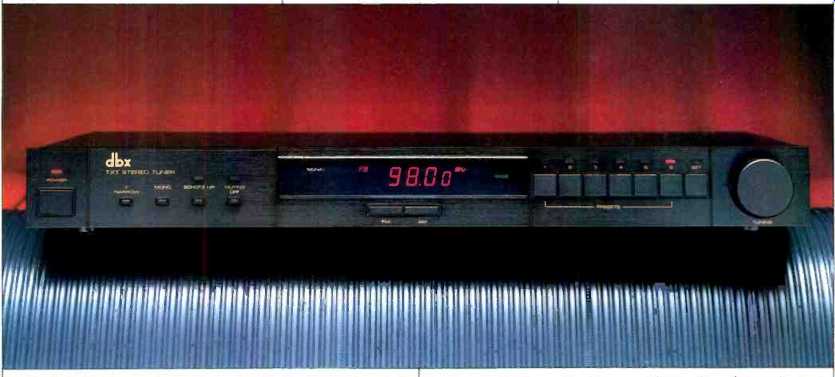
Manufacturer's Specifications:
FM Section
Usable Sensitivity: Mono, 9.4 dBf.
50-dB Quieting Sensitivity: Mono, 11.2 dBf; stereo, 38 dBf.
S/N: Mono, 85 dB; stereo, 79 dB.
THD + N: Mono, 0.06% for wide i.f. and 0.3% for narrow i.f.; stereo, 0.07% for wide i.f. and 0.5% for narrow i.f.
Frequency Response: 20 Hz to 15 kHz, ± 0.35 dB.
Capture Ratio: 1.5 dB.
Alternate-Channel Selectivity: 70 dB.
Adjacent-Channel Selectivity: Wide, 7 dB; narrow, 26 dB
Image Rejection: 100 dB.
I.f. Rejection: 100 dB.
Subcarrier Rejection: 70 dB.
SCA Rejection: 80 dB.
I.f. Bandwidth Switching Threshold: 20.7 dBf.
Stereo Switching Threshold: 20.7 dBf.
Muting Threshold: 20.7 dBf.
Output Level: 1 V for 100% modulation.
AM Section
Sensitivity: 250 µV/m.
S/N: Greater than 45 dB at 1 mV/m, 30% modulation.
THD: 0.5% at 5 mV/m.
Frequency Response: 40 Hz to 5 kHz, ±2 dB (NRSC pre-emphasis).
Selectivity: 70 dB.
I.f. Rejection: 70 dB.
Image Rejection: 45 dB.
Maximum Radio Frequency Input: 3 V/m.
Output Level: 1 V for 1 mV input, 80% modulation.
General Specifications:
Memory Backup: More than 10 days.
Dimensions: 17.1 in. W x 1.75 in. H x 9 in. D (43.4 cm x 4.4 cm x 22.9 cm)
Weight: 3 lbs. (1.4 kg).
Price: $800.
Company Address: P.O. Box 100C, Newton, Mass. 02195.
-----------------
Larry Schotz, who helped design the dbx TX1 tuner, is one of the foremost consumer electronic product designers practicing in the United States. You may remember that some 10 years ago, it was Schotz who startled the audio world with his remarkable Micro/CPU 100 tuner (first sold by Sherwood Electronics, later under the Draco Labs label). To the best of my recollection, that was the first commercially available tuner to employ frequency-synthesized tuning.
Among its novel features was the ability to program the alphabetic call letters of its preset stations.
During the intervening years, Schotz has built up an outstanding reputation, primarily in the area of r.f. product design. He has executed successful designs for such companies as NAD, Proton Nakamichi, and Parsec, to name just a few. When dbx decided to broaden their product line to include a tuner, they sought his help. It was a wise move! Over the last couple of years, I've often been troubled by the fact that rarely, if ever, was I able to realize claimed usable sensitivities for most of the FM tuner products I've tested. Oh, it's not that they miss by much. A claimed 10.8 dBf might work out to be 12 or 13 dBf, for example. But that consistent pattern has caused me, more than once, to suspect mis-calibration of my Sound Technology FM generator. Thanks to the dbx TX1 tuner, those doubts have now been dispelled. The claimed mono usable sensitivity of 9.4 dBf (that's not a typo) turned out to actually measure 8.5 dBf. (That's not a typo, either!) But I'm getting way ahead of myself.
The low-profile TX1 incorporates automatic circuits for reducing noise from weak FM stations. The tuner constantly monitors the FM signal for noise, which is normally concentrated at the higher audio frequencies. When noise is detected, the circuit blends together the high frequencies of the two stereo channels to reduce it. Since this blending occurs dynamically, it is only activated when necessary. It also can be introduced, if needed, by the user.
As an aid to tuning in weak stations that are close in frequency to stronger signals, whenever the TX1 senses such situations, it automatically chooses the narrow i.f. mode for greater selectivity and adjacent-channel rejection.
(This feature also can be manually selected.) The unit's circuitry can memorize six AM and six FM station frequencies, and it employs frequency-synthesized tuning with 100 kHz increments on FM and 10-kHz increments on AM. As indicated in the published specs, in the event of a power outage (or if the tuner should be unplugged from an outlet), preset information will be retained for at least 10 days. Usually, the information will be retained for about two weeks.
Although most designers of AM/FM tuners treat the AM section pretty much as an afterthought, in this Schotz design, careful attention has been given to the AM circuits as well as the FM section. For years now, I've been complaining about the poor AM frequency response of so-called high-fidelity tuners and receivers. In one sense, my criticism has been unfair. The fact of the matter is that most manufacturers roll off the high end of their AM tuners in order to reduce background noise and interference, especially during nighttime listening. To compensate for this design approach, most AM stations boost or pre-emphasize the high frequencies of their program content. The situation is not unlike that in FM, with the 75-µS pre-emphasis curve used at the transmitting end and the 75-µS de-emphasis curve employed in all FM tuners intended for use in the United States (it's 50 µS in Europe). Until recently, however, there's been one major difference between the FM and AM approaches to pre-emphasis and de-emphasis: AM stations did pretty much as they pleased. Some pre-emphasized a great deal, some didn't pre-emphasize at all, and there was everything in between. Tuner manufacturers were therefore at a loss to know exactly how to roll off the response of their AM circuitry. Recently, the National Radio Systems Committee (NRSC) decided to do something about the chaotic status of AM. They came up with a defined pre-emphasis curve and urged stations to employ it. Simultaneously, they urged makers of AM tuners to build in the inverse de emphasis curve. It is no surprise to find that Larry Schotz's AM circuit, as found in the TX1, is one of the first to comply with this voluntary standard.
Control Layout
A power on/off button at the left of the tuner's all-black panel has a tiny LED indicator above it. To the right are four very small buttons that select i.f. bandwidth, mono or stereo reception, the Schotz noise-reduction circuitry, and muting.
When either of the last two controls is pressed, a small indicator LED lights up above it. These buttons are of the light-touch variety and do not stay pushed in when activated, so there would be no way of knowing which settings were operating without the LEDs. The i.f. bandwidth and mono/stereo indications, rather than appearing above their respective touch buttons, show up in the main display at the center of the panel, which also has a five-LED signal strength meter. Below are AM and FM band-selector buttons. Further to the right are the six preset buttons, plus the "Set" button, for storing specific AM or FM station frequencies. At the extreme right is a welcome rotary tuning knob.
How can a tuning knob work with a frequency-synthesized tuning system? Simply by coupling the knob to an optical disc fitted with small holes. As the holes pass in front of a beam of light, that light impinges upon a sensor which tells the tuner section how far to move up or down in frequency. To me, there's something more ergonomically pleasing about spinning a tuning knob than leaning on a button and watching the digits change on a display.
The rear panel is equipped with a 75-ohm coaxial connector for a transmission line from your FM antenna, and a pair of terminals for connecting an external AM antenna, if needed. The usual AM rod antenna will probably suffice in most locations, but the owner's manual wisely urges FM listeners to use something better than the supplied T-wire antenna. (The manufacturer devotes 1 1/2 pages of their well written manual to the subject of FM antennas, and it ought to be required reading for anyone who owns an FM tuner or receiver.) If your incoming transmission line is of the 300 ohm, flat twin-lead type, there's no need to buy an accessory transformer; dbx supplies one. Left and right output jacks are located on the right half of the rear panel.
Measurements
As I've mentioned, I was astounded to find that the TX1's mono usable sensitivity measured even lower than its low published specification: 8.5 dBf as against 9.4 dBf claimed.
For you folks who still think microvolts, that's a usable sensitivity of 0.73 µV into a 75-ohm antenna impedance! Stereo usable sensitivity was determined by the stereo threshold rather than by the tuner's actual front-end performance. That threshold (as well as the muting threshold) was set at 20 dBf, which is exactly where I felt it ought to be in terms of optimizing S/N, distortion, and other parameters. A plot of S/N versus signal input is shown in Fig. 1.
Ultimate S/N measured 81 dB for mono and a very high 79 dB for stereo. Since S/N was the same whether the tuner was in the wide or narrow i.f. mode, I saw no point in plotting both, though it should be noted that the usable sensitivity in the narrow mode was slightly worse than in the wide. This is attributable to the higher level of THD in the narrow mode rather than to any increase in noise.
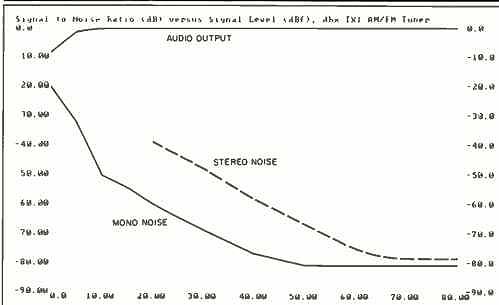
Fig. 1--Mono and stereo quieting characteristics, wide i.f. mode. Ultimate
S/N in narrow i.f. mode was identical, although usable sensitivity was not
quite as good.
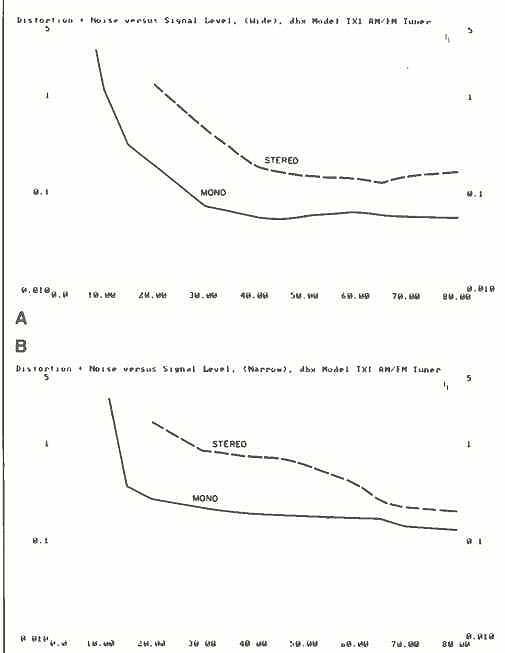
Fig. 2--THD + N vs. signal strength at 1 kHz for wide (A) and narrow (B) i.f.
modes.
Figure 2 shows how THD + N varied as a function of signal input level. In the wide mode (Fig. 2A), THD + N measured 0.06% in mono and 0.13% in stereo at 65 dBf for a 1-kHz modulating signal. In the narrow i.f. mode (Fig. 2B), THD + N increased to 0.17% in mono and was 0.25% in stereo. Both results in the narrow mode are only about half of those specified by dbx.
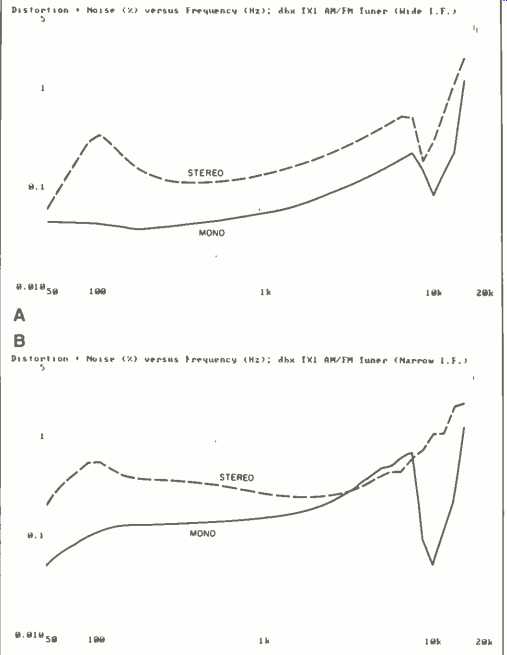
Fig. 3--THD + N vs. frequency for wide (A) and narrow (B) i.f. modes.
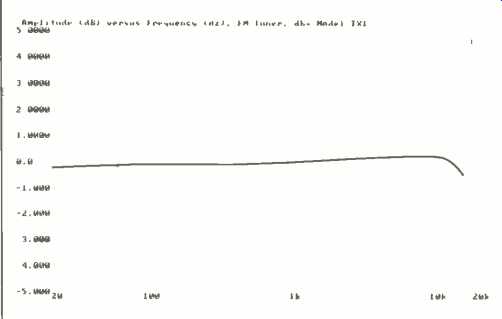
Fig. 4--FM frequency response. Note vertical scale of dB/div.
Plots of THD + N versus frequency are presented in Fig. 3. For the wide i.f. mode (Fig. 3A), the rather odd shape of both curves, above 7.5 kHz or so, is due to a filter whose use is mandated by the EIA/IEEE Tuner Measurement Standard. This filter's cutoff frequencies are set at 200 Hz and 15 kHz (the second harmonic of 7.5 kHz). At 100 Hz and 6 kHz (the two frequencies other than 1 kHz at which distortion is supposed to be reported), THD + N was 0.042% and 0.18%, respectively, in mono and 0.32% and 0.5% in stereo.
Switching to the narrow i.f. mode (Fig. 3B), again at 100 Hz and 6 kHz respectively, THD + N was 0.11% and 0.6% in mono; for stereo, results were 0.57% and 0.49%.
Figure 4 shows FM frequency response from 20 Hz to 15 kHz (the highest audio frequency broadcast on FM). Maximum deviation from flat response was no more than +0.2 dB and-0.35 dB. An important point concerning good FM design is illustrated in Fig. 5. Conventional wisdom has always maintained that switching from a wide to a narrow i.f. tuning mode (to overcome adjacent or even alternate channel interference) inevitably means giving up separation as well as lowest possible distortion levels. In this Schotz-designed tuner, "conventional wisdom" holds as far as the higher distortion is concerned. But look at Fig. 5A, a plot of frequency response of one modulated stereo channel (solid curves) and of separation or output of the unmodulated channel (dashed curves). In this case, the decrease in separation when switching from wide to narrow i.f. bandwidth was insignificant, even when you take into account the slight change in output level shown by the two response curves. Separation at 1 kHz, for example, decreased only from 54 to about 50 dB at 1 kHz. It remained virtually unchanged at 10 kHz (around 39 dB) and decreased from 52.5 to about 47.5 dB at 100 Hz. That's what I call good stereo multiplex decoder and i.f. circuit engineering.
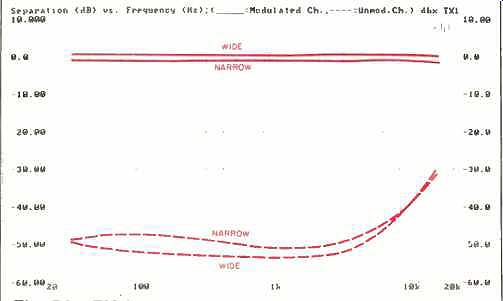
Fig. 5A--FM frequency response (top curves) and separation (bottom curves)
for both i.f. modes, with signal input of 65 dBf.
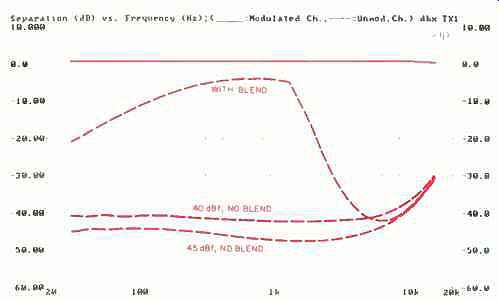
Fig. 5B--Blending effect of Schotz noise-reduction circuit (see text), which
is constant at all signal levels, and separation without NR at levels of 40
and 45 dBf.
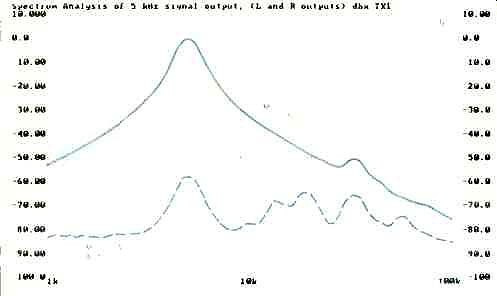
Fig. 6--Separation and crosstalk components for a 5-kHz modulating signal.
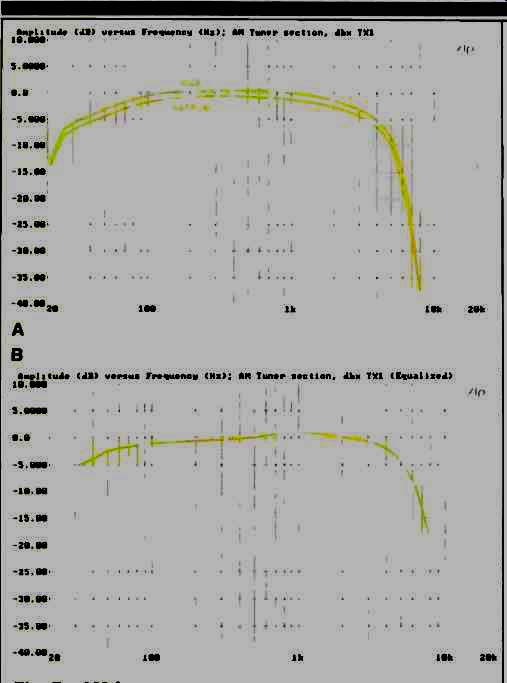
Fig. 7--AM frequency response without pre emphasis in both i.f. modes (A)
and with NRSC pre-emphasis in wide mode (B).
Separation measurements were repeated and plotted in Fig. 5B to ascertain the effect of the Schotz "blend" or noise-reduction circuitry. If these curves are to be believed (and I repeated the tests several times to make sure that I wasn't doing something wrong), the blend characteristics of the Schotz NR circuitry are like no others I have ever measured. Maximum blend occurs at midrange frequencies, while separation increases almost to its original levels (those measured with the Schotz feature turned off) above 5 kHz. The lower curves in Fig. 5B represent separation at 45 and 40 dBf, lower signal levels than the 65 dBf of Fig. 5A. This accounts for the slightly lower separation, even with the Schotz NR circuit switched off.
I pondered for a long time the strange blend separation characteristics seen in Fig. 5B. The only conclusion I could reach was that perhaps Schotz created this kind of blend action because he recognized that human ears are most sensitive to noise in the midrange and upper midrange region, where we see the greatest blending (least separation). He may have also reasoned that the upper midrange is most useful in stereophonic localization and therefore allowed the separation to increase at those frequencies.
Whatever the reasoning, I can attest to the fact that, under weak-signal stereo reception conditions, the Schotz circuit does make a big difference, reducing annoying background noise without sacrificing stereo effects altogether.
Next, I modulated one stereo input of my FM generator with a 5-kHz signal and did a spectrum analysis of the left and right-channel outputs, using the 1/3-octave bandpass filter of my Audio Precision System One test equipment and sweeping from 1 to 100 kHz (Fig. 6). The solid curve represents the output from the modulated channel, in which we see the peak at 5 kHz. The dashed curve was plotted by reading the output of the opposite, unmodulated channel. At 5 kHz (the modulating frequency), separation was an impressively high 58 dB. There is also some evidence of third harmonic crosstalk at 15 kHz (about 70 dB below maximum modulation level), some residual 19-kHz pilot carrier output (about 66 dB down from maximum modulation level), and some 38-kHz residual product signal (about 68 dB down). Capture ratio was exactly 1.5 dB, as claimed. Alternate channel selectivity measured 73 dB, and adjacent-channel selectivity was 7.5 dB in the wide mode and 28 dB in the narrow. Image and i.f. rejection were both above 100 dB. Muting and stereo threshold both measured 20 dBf, and AM rejection was 68 dB. Since dbx published more specifications for AM tuner performance than most makers of AM/FM tuners, I decided to test the AM section a little more extensively than usual. To begin, I measured frequency response without regard to the NRSC pre-emphasis characteristic discussed earlier. Results are shown in Fig. 7A. The only real difference between the curves for wide and narrow i.f. bandwidths was a slight shift in output level. Without pre-emphasis of the signals modulating the AM generator, response rolled off to-6 dB at just over 4 kHz. When I applied pre-emphasis to the modulating signal (Fig. 7B), response was considerably flatter, extending beyond 5 kHz for the -6 dB roll-off point.
As soon as more manufacturers recognize and begin to use this NRSC pre-emphasis characteristic, I will omit the type of plot shown in Fig. 7A and will show only the net response using pre-emphasis.
At a signal input level of 5 mV/m, THD of the AM section measured 0.45%, and S/N (referred to a 30% modulation level) was 47 dB. Sensitivity, with a signal applied directly to the external AM antenna input, was 30 µV. (I have no easy way to measure sensitivity via a supplied loopstick or ferrite rod antenna.)
Use and Listening Tests
The dbx TX1 almost seemed to have a mind of its own when it encountered weak signals or signals that were interfered with by strong adjacent signals. Both of these conditions are easy to find in my listening location, and not once did I feel the need to override the "decisions" made by the Schotz logic circuitry as it switched from wide to narrow or turned the Schotz noise-reduction/stereo-blend circuit on or off. This Schotz blend circuit, as strange as its response appeared in the lab tests, really did the job it was intended to do. There were at least three instances where I encountered stereo signals so noisy that I normally would have switched to mono. Instead, with the Schotz NR circuit automatically activated, those signals became tolerable--although, of course, there was still some background noise. A fourth signal, one that had a moderate amount of noise but could have been tolerated, became virtually noise-free when I manually activated the Schotz NR. Interestingly, for that signal, the Schotz circuit did not automatically switch in; I had to do it manually to enjoy its benefits.
With the kind of usable sensitivity and 50-dB quieting characteristics this tuner exhibits, it almost goes without saying that I was able to log every station I have ever picked up in my location-a total of over 58 at last count. However, atmospheric conditions affect this, too. Some days are better than others, and, as I write this report, there has been unusually violent sun-spot activity which, in the past, has impaired FM reception. Still, the TX1's performance need not take second place to the reference tuner against which I compared it. When you consider that my reference unit costs about twice as much, this is another milestone in the long list of Larry Schotz's achievements and a component that should prove extremely successful for dbx.
-Leonard Feldman
(Source: Audio magazine, Nov. 1988)
Also see: Dynaco AF-6 AM/FM Tuner (Sept. 1974)
= = = =